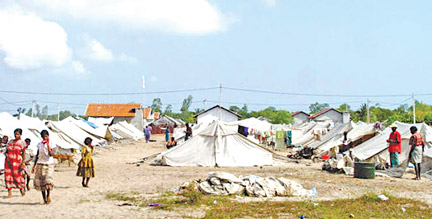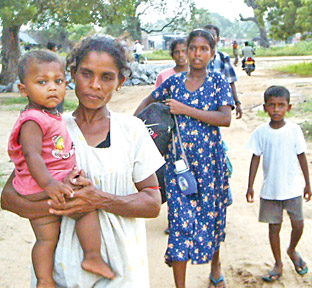Around 3,000 persons awaiting resettlement
by P. Krishnaswamy
Eight hundred and twenty five families consisting of 2,598 members
are still awaiting resettlement in their own once fertile lands in
Sampur, having been displaced along with over 900 other families of the
area in April 2006 as part of the saga of displacement of hundreds of
thousands of families of the North and East during the peak of the
confrontations.
 The
representatives of organisations working for their welfare believe that
the new government, which had assured of every effort to resettle them
in their own lands, will take the necessary initial steps in this regard
during its 100-day program. The
representatives of organisations working for their welfare believe that
the new government, which had assured of every effort to resettle them
in their own lands, will take the necessary initial steps in this regard
during its 100-day program.
Resettlement, Reconstruction and Hindu Religious Affairs Minister
D.M.Swaminathan made an announcement recently that of the 1,400 acres
that were earmarked for the coal power project and several BOI projects,
the Government would retrieve the 800 acres that are meant for the BOI
projects because no work has been started on them, as an initial step
towards resettlement of the families.
At the peak of the confrontation in April 2006, all Tamil families of
11 Grama Niladhari Divisions (GNDs) in the Mutur Divisional Secretary
Division (DSD) fled their homes, overnight in many cases, leaving most
of their valuables and properties just to save their lives.
All the families that have been living in their ancestral lands for
generations and centuries had a decent and contented life, according to
all available records.
In the areas in question abandoned by the fleeing people were 41
irrigation tanks, 1,764 acres of paddy lands, about 600 acres of home
garden lands, 65 fishing grounds, eight Hindu temples, 4 high grade
schools, hospital, MOH office, drinking water supply centre, agrarian
extension centre, fish market complex, cooperative society, library,
Pradeshiya Sabha sub office and other facilities reflecting
progressively thriving local communities, whose mainstay being
agriculture, both paddy and highland crops, fishing, animal husbandry
and home gardening. It was an expansive area of natural forests and many
tanks.
The sufferings of the families, their losses and the untold and
unimaginable woes that they went through since their displacement from
their own homes and lands are heart-rending. They had to move from one
Welfare Centre (WFC) to another very often, many of them had lost their
loved ones, reduced to utter penury and eternally worried over the
education and future of their offspring, according to reports.
Although over the years about 900 families have been resettled,
mostly in their original places of domicile, the fate of the 825
families still remains undecided.
 These
families belonging to Sampur West and Sampur East remain housed in the
WFCs of Pattithidal, Manatchenai, Kattaiparichchan and Kiliveddy. Some
of the families are also with their friends and relatives, according to
reports. These
families belonging to Sampur West and Sampur East remain housed in the
WFCs of Pattithidal, Manatchenai, Kattaiparichchan and Kiliveddy. Some
of the families are also with their friends and relatives, according to
reports.
Reproduced below are two instances of untold sufferings of the
families reproduced from a local Tamil-language tabloid:
"Mylvahanam Thamodaram (78) housed in the Kiliveddy Welfare centre
attempted suicide, by slitting his neck with a razor blade , because the
burden on him was too much for a man of his age who had once had a
decent living.
His married son died during the conflict and his daughter-in-law fled
after deserting their only child (daughter) who is now under the care of
the Malligaitivu Mother Saratha Children's Home.
His married daughter has four children of school going age and her
husband(the son of Thamodaram) is an invalid.
As of now Thamodaram is the only bread winner but at his age he is
unable to do labour jobs. He is worried over the future of the
offspring.
"A widowed woman Rasammah (82) is housed in one of the four welfare
centres and she has to look after her daughter who is mentally deranged
due to the course of events that rocked her family. She has nobody to
support.
The food relief extended to the refugee families by the FAO was
discontinued from the year 2011".
These instances reflect the woes of a majority of the families in the
welfare centres.
The families complain that they are being treated as outcasts by the
camp authorities and the camp life is no better than a beggar's life,
according to the reports.
According to representatives of organisations working for the welfare
of the refugees, under the prevailing circumstances, at least 70 percent
of the lands of the displaced refugees now earmarked for the 'Sampur
Special Economic Zone (SSEZ)' and the High Security Zone (HSZ) can be
retrieved to be given back to the respective families because other
suitable areas in the vicinity are available for locating both the SSEZ
and the HSZ. |

